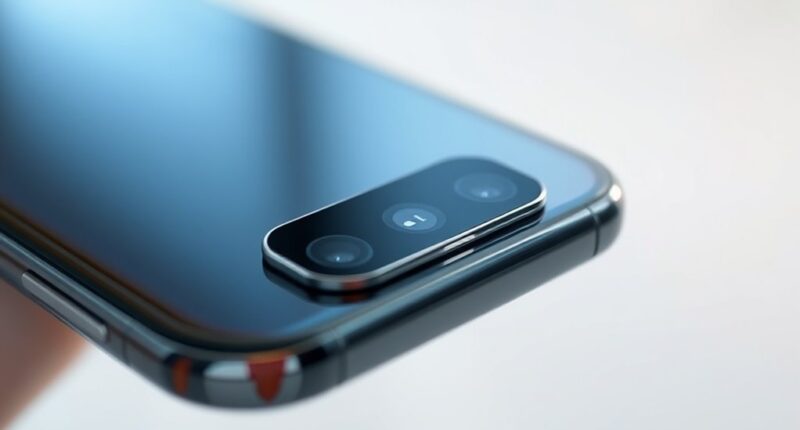Under-display cameras face the challenge of light diffraction caused by placing the lens beneath the screen, which can blur images and produce artifacts. Manufacturers reduce pixel density in the camera area and use advanced materials to improve transparency. They also rely on sophisticated AI algorithms to enhance photo quality and compensate for optical limitations. If you want to understand how new tech tackles these diffraction puzzles and improves clarity, keep exploring these innovative solutions.
Key Takeaways
- Advances in display materials and pixel arrangements aim to reduce diffraction effects around the camera area.
- AI and multi-frame computational photography enhance image clarity and compensate for optical limitations.
- Increasing screen brightness helps mask blurry patches and diffraction artifacts during everyday use.
- Ongoing research seeks to optimize transparency without sacrificing display quality or introducing optical distortions.
- Combining hardware improvements with sophisticated software processing is key to solving the diffraction puzzle in under-display cameras.

Have you ever wondered how smartphones can offer a seamless, full-screen experience without visible cameras? The secret lies in under-display camera (UDC) technology, which places the front-facing camera beneath the screen itself. This design allows you to enjoy an uninterrupted display, free from notches or punch holes. To make this possible, the screen pixel density is intentionally reduced in the camera area. This creates a transparent zone that lets light pass through to the sensor, all while maintaining a visually appealing display. Many manufacturers use a dual-layer approach: the primary OLED or LED panel, paired with a secondary transparent layer made from special glass positioned above the camera. Although innovative, this transparent patch can sometimes show a “blurrier patch” or pixelation, especially when viewing darker content or using the screen at low brightness. Increasing brightness can help mask these imperfections, making the camera zone less noticeable during everyday use.
However, integrating a camera beneath the display introduces optical challenges rooted in physics. The tiny gaps between pixels—acting as tiny apertures—cause diffraction artifacts. These artifacts manifest as flare, saturation, blur, and haze in photos taken through the display. Light passing through multiple layers, including glass and pixel grids, can distort or partially block the input to the camera sensor, leading to a reduction in image clarity. While efforts to alter pixel density or pixel layout can reduce these effects, they can’t entirely eliminate diffraction. Physical limits exist on how transparent and distortion-free the display can be made around the camera zone, which means some trade-offs are inevitable. Sharpness and clarity are compromised to some degree to preserve the seamless display experience. Research into advanced materials and pixel arrangement techniques] continues to push the boundaries of what is possible, aiming to improve this aspect in future designs.
To counteract these optical limitations, manufacturers rely heavily on software and AI-based image processing. Advanced algorithms perform multi-frame computational photography, restoring details and reducing artifacts after capture. For example, Samsung’s Galaxy Z Fold4 employs AI-driven pipelines that enhance photo quality, improve preview accuracy, and smooth out haze and blur. This digital post-processing compensates for the optical compromises, enabling users to produce images that approach traditional camera quality. Although these improvements are impressive, they come with slight delays due to the computational effort involved. Furthermore, ongoing research into display materials and pixel arrangements aims to further mitigate diffraction effects and improve image clarity in future under-display camera implementations.
Frequently Asked Questions
How Do Under-Display Cameras Impact Battery Life?
You might notice that under-display cameras can slightly reduce your device’s battery life. This happens because the display stays active in the camera area, requiring more brightness and power. When you use features like video calls, selfies, or gaming, the power demand increases due to higher display activity and sensor use. However, manufacturers optimize settings like adaptive refresh rates and pixel control to minimize this impact, keeping your device efficient.
What Materials Are Used for the Display to Optimize Camera Performance?
They say “a picture is worth a thousand words,” and with under-display cameras, your device’s display materials play a key role. You benefit from specialized transparent layers, like CPM™ patterning, that let light pass through without sacrificing screen quality. These materials balance brightness and reduce diffraction, enabling clearer images. Advanced cathode and pixel arrangements further enhance camera performance, ensuring your device captures sharp photos while keeping the display seamless and stunning.
Can Under-Display Cameras Be Used for 3D Face Recognition?
Yes, you can use under-display cameras for 3D face recognition. Although it’s challenging, manufacturers are developing technology that combines invisible cameras with infrared sensors and structured light to enable 3D facial scanning beneath the screen. They’re working to improve accuracy and security while maintaining a seamless display. With ongoing innovations, expect to see this advanced biometric feature integrated into future smartphones, offering both security and sleek design.
How Do Manufacturers Ensure Privacy With Under-Display Cameras?
You want to know how manufacturers protect your privacy with under-display cameras. They hide the camera behind transparent parts of your screen, often in less noticeable areas like the status bar, to keep it discreet. Advanced features like IR sensors and optical stabilization improve security and clarity. Regular software updates also patch vulnerabilities, ensuring your biometric data stays safe. Leading brands adopt these measures to balance privacy, security, and sleek design.
Are There Any Health Concerns Related to Under-Display Camera Technology?
They say “better safe than sorry,” but current science shows no direct health risks from under-display cameras. You won’t be exposed to harmful radiation or physiological harm, as these cameras use standard sensors and light levels. Minor light scattering may occur, but it doesn’t usually cause eye strain or discomfort. Overall, UDCs are safe to use, with no proven health concerns linked to their operation or light diffraction.
Conclusion
You might think under-display cameras are just a clever trick, but recent advances suggest they could truly revolutionize your device’s design. Some experts believe that with improved light diffraction techniques, we can overcome current visibility issues, making the camera almost invisible without sacrificing quality. While challenges remain, the science behind light manipulation shows promising potential. So, it’s worth wondering—could this technology become the new standard, seamlessly blending form and function in your future devices?









